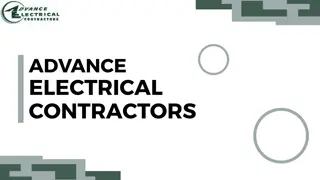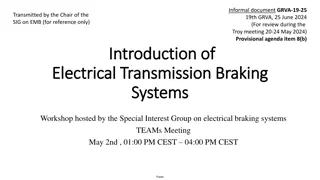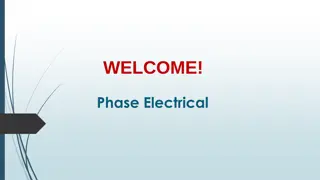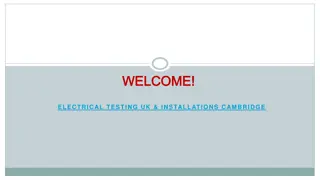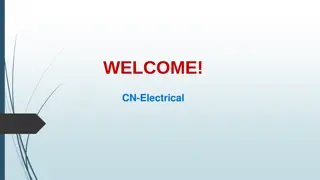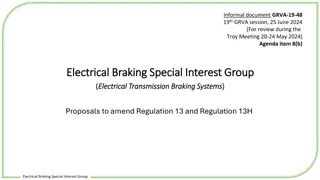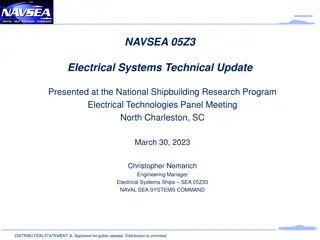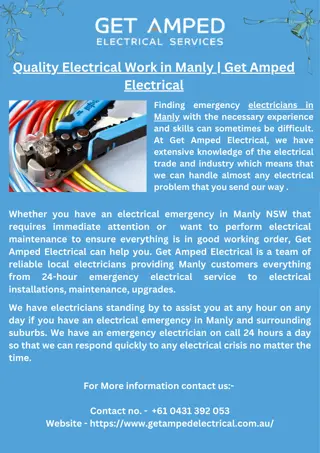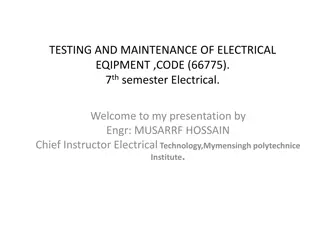
Teaching Electrical: Practical Insights and Hands-On Learning
Explore practical insights and hands-on learning techniques in electrical teaching with Jim Halderman. Discover engaging topics like meter usage, wire repair, project-based learning, and more. Understand why students choose automotive education and learn essential concepts such as voltage testing, series demonstrations, and body resistance measurements. Enhance your teaching approach and engage students effectively in the field of electrical engineering.
Download Presentation

Please find below an Image/Link to download the presentation.
The content on the website is provided AS IS for your information and personal use only. It may not be sold, licensed, or shared on other websites without obtaining consent from the author. If you encounter any issues during the download, it is possible that the publisher has removed the file from their server.
You are allowed to download the files provided on this website for personal or commercial use, subject to the condition that they are used lawfully. All files are the property of their respective owners.
The content on the website is provided AS IS for your information and personal use only. It may not be sold, licensed, or shared on other websites without obtaining consent from the author.
E N D
Presentation Transcript
Have Fun Teaching Electrical Jim Halderman 1
Introduction Former flat-rate technician Former automotive college instructor Author of many automotive textbooks Still plays with cars Lives in Dayton, Ohio 2
Topics to be Discussed Meter usage made fun Wire repair-meter fuse Project-based learning LED test light Memory saver Speaker tester Theft deterrent Logic probe 3
Why do students take Automotive? Not to do math problems Not to learn a lot of theory They attend to learn how things work They want hands-on activities 4
Where do I start? Touching a battery Many in the class would not touch the terminals Gives them the hands- on knowledge of: Battery voltage (low) Body resistance (high) 5
You cant see or feel electricity They have to measure electricity Voltage is the most commonly used measurement specified Measure voltage on their vehicles 6
Voltage Testing DC Volts is the most commonly used A V with a straight line above it. AC volts is a V with a wavy line on top 8
Series Demonstration A typical nine-volt battery contains six 1.5 volt AAAA batteries connected in series. The voltage adds would connected in series (1.5 X 6= 9 Volts) Students will never forget this 9
Dry Cell Battery Drop Test Good battery- stays up or bounces once Discharged battery- bouncesseveral times Does not always work Use a voltmeter 10
Measure body resistance Gets students to use the meter Should them the Ohms symbol Show them where to place the test leads How much is normal? 11
Need to measure k-Ohms Normal body resistance is 200k to 400k Ohms If lower means dehydrated Can be over one million so they will measure 1.1 Meg Ohms which really confuses them 12
Meter scales 14
What the meter reading means Think of MONEY! 1.00 = a dollar 0.50= fifty cents or a half dollar 0.25 = quarter 0.01 = a penny Milliamps I compare to thousandth of an inch such as bearing clearance. 0.020 amp is like 20 thousandth of an inch 15
Ammeter 16
Protect the meter Fuse the meter lead Saves money because the expensive internal fuse will be protected. Use a 10 A. Fuse Tie a knot in the leads- keeps them from getting tangled 18
Project Based Learning The first week, students get a meter. We use the meter every day starting with checking their body resistance. Asked to purchase some low cost electrical parts that they can use to build projects for their project grade 19
Speaker Tester Uses a 1.5 volt battery Connect to the speaker terminals If positive (+) is to the positive terminal, the speaker cone moves away from2020 the coil 20
Air Bag Diagnostic Tool Use a 2 watt resistor as load tool to replace a module Most modules measure 1.5 to 3.5 Ohms 21
Shorting Bars When an air bag module is disconnected, spring-loaded shorting bars short the two terminals together Use stir straw to cover one of the shorting bars 22
Lighter Plug Tester Uses a double banana plug Terminals are inch apart-the same for all meters Lighter plug Some wire 23
Lighter Plug Tester Usage Domestic vehicles- Lighter (power)plug is hot at all times Import brands- Controlled through the ignition 24
Using the lighter Plug-#1 Battery Testing- Connect and watch voltmeter and turn on high beam headlights. Watch voltage drop After it stabilizes, turn off the lights Watch how fast the voltage increases The final voltage is the SOC. 25
Using the lighter Plug-#2 Cranking voltage- Crank the engine Observe the battery voltage Should be above 9.6 Volts during cranking 26
Using the lighter Plug-#3 Charging Voltage- Start the engine and observe the voltmeter Should be 13.5-15.0 Volts 27
Using the lighter Plug-#4 AC Ripple Voltage- Start the engine Turn on the headlights to provide an electrical load Switch meter to read AC volts Should be less than 0.5 Volt 28
Diodes I do not wait to get to the electronics part of the course to teach diodes Most students can easily understand a diode 29
LEDs Red Green Blue Anode (+) Cathode (-) A comes before C so the anode is the positive and the cathode is the negative 30
LED Test Light One LED One 470 W resistor A clicker style pen Some wire etc. 31
Memory Saver Very popular Can be used with a 9- Volt battery Can be connected to a jump box 32
OBD II DLC Memory Saver Use OBD II male connector Pin #4(-) and #16(+) to lighter plug and to a jump box 33
Theft Deterrent Very popular Many students build this and install on their own vehicle Easy to build How does it work? 34
Logic Probe Use to check for power and ground A test light can only detect power (unless connected to power) 35
Parts List PROJECT #1 (Air Bag load tool) PROJECT #4 (LED test light) LED 470 ohm resistor-1/2 Watt Two stripped wires 1 wire nut 2 ohm resistor and label One stir stick straw PROJECT #2 (Speaker tester) Battery holder PROJECT #5 (Logic probe) One red LED One green LED Two-470 ohm resistors Three stripped wires 3 wire nuts PROJECT #3 (Lighter plug test tool) Double banana plug Lighter plug (male end with wire) need to cut and strip wire Two black cable ties Pocket screwdriver 36
Electrical parts suppliers that I use www.amazon.com www.vetco.net www.meci.com (Mendelsons) www.parts-express.com www.radioshack.com 39
Summary Students love hands-on activities I try to get their hands on meters as soon as possible I give them projects that they can make using low-cost parts. Projects that are useful Have fun teaching electrical 40
Contact Information Jim@jameshalderman.com For a copy of this presentation go to: www.jameshalderman.com Click on Jim s Stuff Click on Conference Power Points 41


